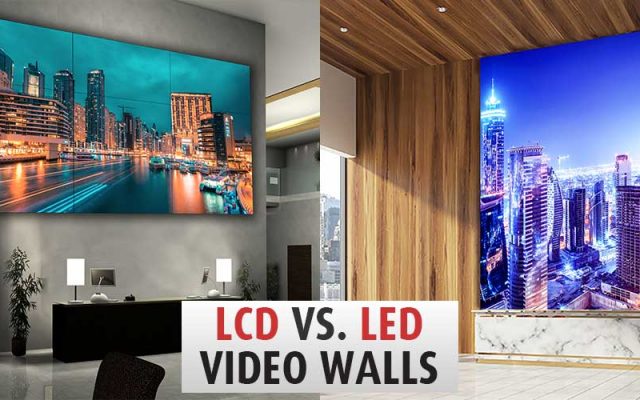Even though they may sound similar, LCD and LED (also known as “direct view LED”) are two different display technologies with their own distinctive features and benefits. When deciding whether you should invest in LED or LCD displays for your video wall solution, you should have a thorough understanding of the pros and cons associated with each display type.
LCD Video Walls
What is LCD?
LCD (Liquid Crystal Display) is a type of flat panel display that has been very popular in the video wall, commercial digital signage and consumer electronics markets. Most likely, you already use LCD screens in your daily life, as they are used in most smartphones, computer monitors and TV screens. LCD panels are made up of a layer of liquid crystal placed between two pieces of polarized glass. When liquid crystals are energized with electric current, the crystals shift, allowing light to pass through to create an image. Since liquid crystals do not emit their own light, backlights are required behind the glass to illuminate the display. LEDs (light-emitting diodes) are the most commonly used type of backlight today.
Advantages of LCD Video Walls
LCDs are bright, affordable and provide excellent visual detail and performance. LCD is an exceptionally high-resolution technology. Therefore, LCD video walls can display visual content in sharp, vivid detail. These advantages make LCD screens an excellent option for a wide range of video wall applications.
Disadvantages of LCD Video Walls
When LCD screens are combined together to form a video wall, bezels (or seams) are visible between the individual screens. This can be seen as a disadvantage when comparing LCD video walls to seamless LED video walls. Nonetheless, manufacturers are reducing bezel-width with every new generation of displays, so you will notice the bezels on newer LCD screens are much thinner than that of older LCD displays.
LED Video Walls
What is LED?
Direct View LED (as known as just “LED”) is a display type that uses light-emitting diodes (LEDs). In a Direct View LED display, hundreds of small LEDs are mounted directly on a panel, without the use of liquid crystal or polarized glass. Instead of being used as a backlight (like they do in LCD screens), the LEDs in Direct View LED signage produce images themselves. Each LED is a tiny light bulb that converts electrical energy into visible light. The chemical compound used within an LED determines its colour, brightness and power efficiency. Groups of red, green, and blue LEDs are combined on the panel, resulting in the full-color pixels required to develop an image.
At one time, Direct View LED was a lower-resolution display type used primarily in large-scale outdoor digital signage. However, since the development of smaller LEDs in recent years have made much higher resolutions possible, Direct View LED has become an exciting new option for indoor video walls.
Advantages of LED
Unlike LCD displays, Direct View LED panels do not have any bezels. Therefore, they can be combined together to form a completely seamless video wall. In addition, LED displays are exceptionally bright, energy-efficient, and have the most accurate colours and the best refresh rates of any display type available on the market today. These features make Direct View LED a great option for large-scale video walls that require high-impact visuals.
Disadvantages of LED
Even though prices of LED video walls are bound to decrease in the future, they are currently more expensive than LCD video walls. Furthermore, even the highest-resolution LED displays still do not have the ultra-high resolutions available from LCD screens. For video wall applications that require fine details and close viewing range, LCD screens are still the preferred display type.
About Netvisual
Netvisual is a full-service provider of digital signage and video wall solutions. Netvisual providers LCD, LED, mosaic and artistic video wall solutions for a wide range of industries across Canada and the USA. Learn more on our video walls page.
Start your video wall project today!
Let our team of passionate video wall experts guide you through your next project.

